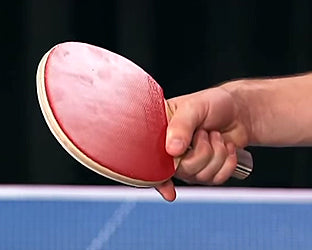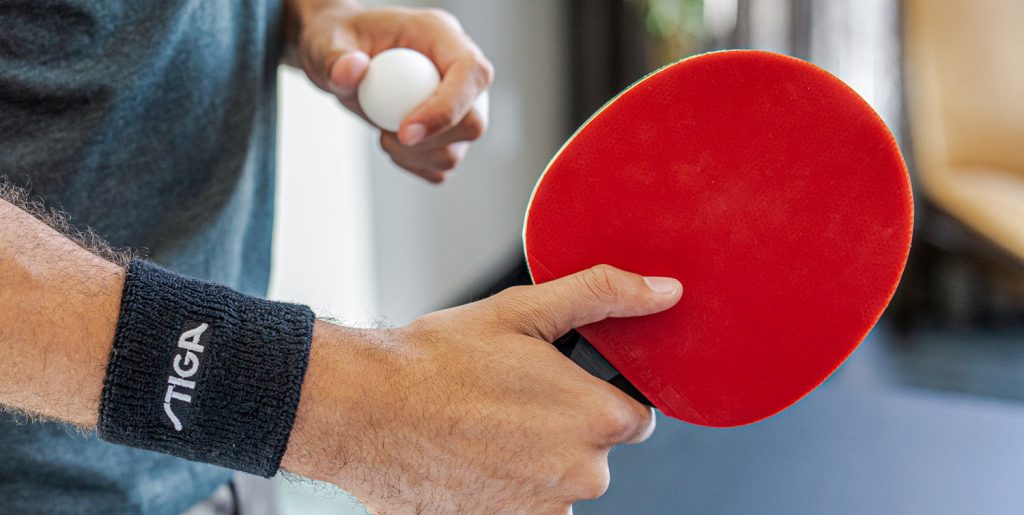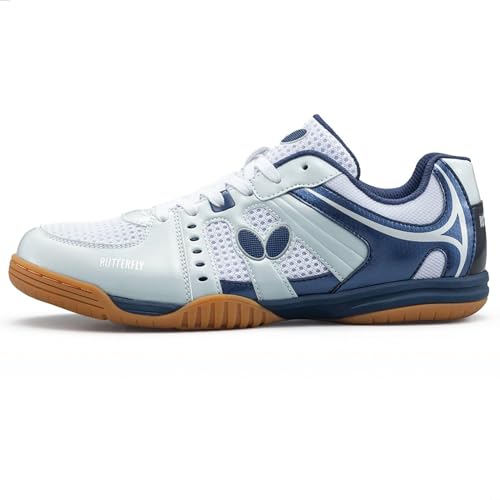Holding a ping pong paddle correctly is crucial. It affects your control and shots.
Ping pong, or table tennis, is a fun and fast-paced sport. But, to play well, you need the right technique. One key aspect is how you hold the paddle. A proper grip can make a big difference in your game.
It influences your control, power, and accuracy. In this guide, we will explore the best ways to hold a ping pong paddle. Whether you are a beginner or looking to improve, understanding these grips is essential. Let’s dive in and see how a simple adjustment can enhance your play.
Introduction To Ping Pong Paddle Grip
Learning how to hold a ping pong paddle is crucial. It can change your game. A proper grip helps in better control and precision. There are different types of grips. Each has its own benefits and drawbacks. Let’s dive into the basics of ping pong paddle grips.
Importance Of Proper Grip
A proper grip is essential for a good game. It ensures better control over the paddle. This control translates to better shots and spins. With a proper grip, you can hit the ball more accurately. It also reduces the risk of injuries. Holding the paddle correctly can prevent wrist strain. It makes playing more comfortable and enjoyable.
Common Mistakes
Beginners often make grip mistakes. One common mistake is holding the paddle too tight. This can cause tension in the wrist. It also reduces flexibility. Another mistake is improper finger placement. Fingers should be relaxed but firm. Incorrect finger placement can lead to poor control. It can also cause the paddle to slip during play.
Another frequent error is using the wrong grip for the wrong shot. Each shot may require a different grip. Using the same grip for all shots can limit your game. It’s important to practice and find the right grip for each shot.
| Common Mistakes | Impact |
|---|---|
| Holding too tight | Reduces flexibility and causes tension |
| Improper finger placement | Leads to poor control |
| Using the same grip for all shots | Limits game potential |
Remember, practice makes perfect. Keep experimenting with different grips. Find what works best for you.

Credit: www.youtube.com
Choosing The Right Paddle
Choosing the right paddle is essential for playing ping pong well. The paddle can affect your control, speed, and spin. Understanding the different types of paddles and what factors to consider will help you make the best choice.
Types Of Paddles
There are different types of paddles, each suited for various playing styles. Here’s a quick overview:
- Beginner Paddles: These paddles are designed for new players. They offer good control but limited speed and spin.
- Intermediate Paddles: Suitable for players who have some experience. They provide a balance of control, speed, and spin.
- Advanced Paddles: These paddles are for skilled players. They offer high speed and spin but require good control.
Factors To Consider
When selecting a paddle, consider the following factors:
| Factor | Details |
|---|---|
| Weight | Lighter paddles provide better control, while heavier paddles offer more power. |
| Handle Type | Handles can be flared, straight, or anatomical. Choose one that feels comfortable in your hand. |
| Rubber Type | The rubber on the paddle affects spin and speed. Pips-in rubber offers more spin, while pips-out rubber gives better control. |
| Blade Material | Blades can be made of wood, carbon, or a mix of materials. Wood offers better control, while carbon provides more speed. |
Note: Always try different paddles before making a purchase. The right paddle should feel comfortable and enhance your playing style.
Basic Grip Techniques
Learning how to hold a ping pong paddle properly is crucial. A correct grip can improve your game significantly. There are two main grip techniques. These are the Shakehand Grip and the Penhold Grip. Each grip has its own advantages and style.
Shakehand Grip
The Shakehand Grip is the most common in ping pong. It is similar to shaking hands with someone. Hold the paddle as if you are about to shake hands. Place your index finger on the rubber part of the paddle. Your thumb should be on the opposite side, resting on the handle. This grip offers good control and power. It is suitable for both beginners and advanced players.
Penhold Grip
The Penhold Grip is popular among Asian players. It resembles holding a pen. Grip the paddle with the thumb and index finger. The other fingers curl around the handle or rest on the back of the paddle. This grip allows for better wrist movement. It is great for close-to-the-table play and quick reactions.

Credit: www.wikihow.com
Advanced Grip Techniques
Advanced grip techniques can enhance your ping pong game. With these grips, you can control the ball better and play with more precision. Let’s dive into two advanced grips that many top players use: the Seemiller Grip and the V-Grip.
Seemiller Grip
The Seemiller Grip is named after Dan Seemiller, a renowned American table tennis player. This grip is unique and offers great control. To use this grip, place your thumb and index finger on either side of the paddle’s edge. The paddle’s handle rests between your thumb and index finger. Your other fingers wrap around the handle.
With this grip, you can perform quick backhand and forehand strokes. It’s great for blocking and counter-attacking. Many players find this grip comfortable and effective for their playing style.
V-grip
The V-Grip is another advanced technique. It provides a different angle to hold the paddle. To do this, form a V with your thumb and index finger. Place the paddle handle between them. Your other fingers wrap around the paddle’s handle. The grip can feel awkward at first, but it offers a unique advantage.
It allows for quick wrist movements and spin control. Many players use this grip for its flexibility and versatility in play. The V-Grip can improve your game by giving you an edge in tricky shots.
Adjusting Your Grip
Adjusting your grip in ping pong is crucial for better control and precision. A proper grip can enhance your game and make your shots more accurate. Let’s explore some essential aspects of adjusting your grip.
Grip Pressure
How tightly you hold the paddle impacts your control. A relaxed grip helps with quick movements. It also reduces muscle tension. Avoid gripping too tightly. This can limit your wrist movement. A firm but relaxed hold is ideal.
Finger Placement
Correct finger placement ensures a stable grip. Place your thumb on the handle’s front. Your index finger should rest along the paddle’s back. The other fingers should wrap around the handle. This balanced placement aids in better control and precision.
Grip And Playing Style
The way you hold a ping pong paddle can greatly impact your playing style. Whether you prefer an offensive or defensive approach, mastering your grip is essential. Let’s dive into the different grips and how they align with your playing style.
Offensive Play
In offensive play, the grip is crucial for generating power and speed. The Shakehand Grip is popular among offensive players. This grip resembles a handshake.
To use the Shakehand Grip:
- Hold the paddle as if shaking hands.
- Wrap your fingers around the handle.
- Your index finger should rest on the back of the paddle.
This grip allows for powerful forehand and backhand strokes. It enables quick wrist movements for smashing the ball.
Another option is the Penhold Grip. This grip is common among players who favor spin and speed.
To use the Penhold Grip:
- Hold the paddle like a pen.
- Wrap your thumb and index finger around the handle.
- Keep the other fingers behind the paddle.
The Penhold Grip offers flexibility for wrist movements. It is ideal for fast attacks and quick returns.
Defensive Play
For defensive play, control and precision are key. The Shakehand Grip can also be effective for defensive players.
With this grip, you can easily switch between forehand and backhand. It allows for better control and placement of the ball.
The Seemiller Grip is another option for defensive players. Named after American player Danny Seemiller, this grip offers a unique advantage.
To use the Seemiller Grip:
- Hold the paddle with your thumb and index finger on the blade.
- Place your other fingers on the handle.
- Angle the blade slightly forward.
This grip provides excellent control and spin. It is great for blocking and countering attacks.
Choosing the right grip can enhance your game. Experiment with different grips to find what suits your style best.
Training And Practice
Training and practice are essential for mastering how to hold a ping pong paddle. With regular practice, you can improve your grip, gain better control, and enhance your game. Below are some effective drills and tips to help you on your journey.
Drills For Grip Improvement
Improving your grip is crucial for handling the paddle with ease. Try these drills to strengthen your grip:
- Shadow Play: Practice your strokes without a ball. Focus on your hand position and grip.
- Grip Switching: Alternate between the shakehand grip and the penhold grip for flexibility.
- Wall Hits: Hit the ball against a wall. Pay attention to how you hold the paddle.
Consistency And Control
Consistency and control are key to a good game. Here are some drills to improve these skills:
- Forehand and Backhand Hits: Practice hitting the ball with both sides of the paddle. This helps in maintaining control.
- Service Drills: Focus on serving the ball with different spins. This improves your grip and control.
- Table Tennis Robot: Use a table tennis robot to practice returning balls. This enhances consistency.
Regular practice with these drills will help you hold the ping pong paddle confidently. Remember, practice makes perfect.
Common Grip Problems
Holding a ping pong paddle correctly can be challenging. Many players face common grip problems that affect their game. Let’s explore these issues and how to address them.
Slipping Paddle
One common issue is the paddle slipping during play. This can happen for several reasons. Sweaty hands can make the paddle hard to hold. A loose grip can also cause slipping. To fix this, keep your hands dry. Use a towel between points. Tighten your grip slightly but don’t overdo it. A firm but relaxed hold works best.
Grip Fatigue
Another common problem is grip fatigue. Holding the paddle too tightly can tire your hand. This can lead to mistakes in your game. To avoid this, find a balance. Hold the paddle firmly but not too tight. Take breaks and stretch your hands. Practice holding the paddle for longer periods to build endurance.
Maintaining Your Paddle
Holding a ping pong paddle correctly is just the start. Properly maintaining your paddle ensures it stays in top condition. Keep it clean and store it properly to extend its lifespan. Here are some tips to help you maintain your paddle.
Cleaning Tips
Regular cleaning of your ping pong paddle is essential. Dirt and oil from your hands can affect your grip and control. Here are some simple steps to keep it clean:
- Use a soft cloth: Wipe the rubber surface with a damp cloth.
- Mild soap: If needed, use a small amount of mild soap.
- Avoid harsh chemicals: They can damage the rubber.
- Dry thoroughly: Make sure the paddle is completely dry before storing.
Storage Solutions
Proper storage is crucial for maintaining your paddle. Here are some tips:
- Use a paddle case: Protects from dust and damage.
- Avoid extreme temperatures: Keep the paddle in a cool, dry place.
- Keep away from direct sunlight: UV rays can degrade the rubber.
- Store flat: Prevents warping of the paddle.
By following these simple tips, you can ensure your paddle remains in excellent condition. A well-maintained paddle will help you play your best game.

Credit: www.killerspin.com
Frequently Asked Questions
How Do You Hold A Ping Pong Paddle?
To hold a ping pong paddle, grip it with your thumb and index finger. Your remaining fingers should wrap around the handle. Ensure a relaxed but firm grip to maintain control and precision during play.
What Is The Shakehand Grip In Ping Pong?
The shakehand grip resembles a handshake. Your thumb and index finger wrap around the paddle’s handle. This grip is popular due to its versatility and ease of use.
Which Is Better, Shakehand Or Penhold Grip?
Both grips have advantages. Shakehand is versatile and easier for beginners. Penhold offers better wrist flexibility for spin. Choose based on your comfort and playing style.
How Tight Should You Hold A Ping Pong Paddle?
Hold the paddle firmly but not too tight. A relaxed grip allows better control and flexibility. Tension can reduce precision and increase fatigue.
Conclusion
Mastering the grip on a ping pong paddle is crucial. It improves control and precision. Practice the correct hold regularly. Experiment with different grips to find comfort. Remember, consistency is key. Keep your wrist relaxed. Focus on technique rather than power.
Watch professional players for tips. Small adjustments can make a big difference. Enjoy the game and have fun learning. With practice, you will see progress. Happy playing!



